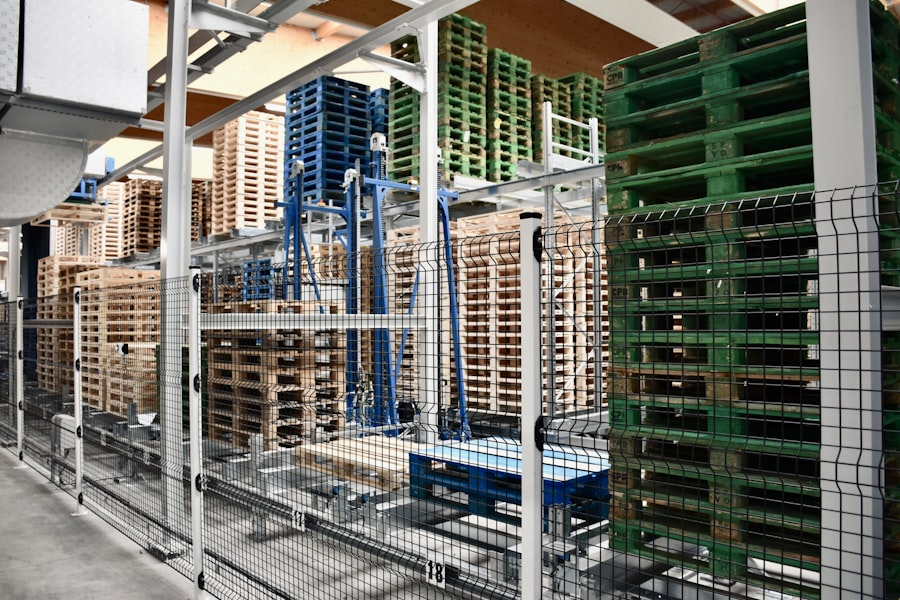
Laborers and freight movers are the backbone of America’s economy, playing a crucial role in various sectors that drive growth and development. These individuals are responsible for the physical movement of goods, which is essential for trade, commerce, and overall economic stability. The U.S. economy relies heavily on the efficient transportation of products from manufacturers to consumers, and laborers are at the forefront of this process. Their work ensures that shelves are stocked, businesses can operate smoothly, and consumers have access to the goods they need. The significance of laborers and freight movers extends beyond mere logistics; they contribute to job creation and economic resilience. According to the Bureau of Labor Statistics, millions of Americans are employed in transportation and material moving occupations, which include truck drivers, warehouse workers, and freight handlers. These jobs not only provide livelihoods for individuals but also stimulate local economies through spending and investment. The ripple effect of their work can be seen in various industries, from retail to manufacturing, highlighting their integral role in maintaining a robust economic framework.
Key Takeaways
- Laborers and freight movers play a crucial role in America’s economy by ensuring the smooth movement of goods and materials.
- They are essential in supply chain management, as they are responsible for loading, unloading, and transporting goods to their destinations.
- Laborers and freight movers face challenges such as long hours, physical strain, and safety hazards in their occupations.
- Their impact on the transportation industry is significant, as they are the backbone of the logistics and distribution process.
- The physical demands of laborer and freight mover occupations require strength, stamina, and agility to perform their duties effectively.
- Technological advancements such as automation and tracking systems are changing the way laborers and freight movers work.
- The future of laborers and freight movers in America will likely involve increased use of technology and a focus on safety and efficiency.
- Their contributions to American society are invaluable, as they ensure the timely delivery of goods and materials that drive the economy.
The Role of Laborers and Freight Movers in Supply Chain Management
Laborers and freight movers are pivotal in the intricate web of supply chain management. They facilitate the seamless flow of goods from suppliers to consumers, ensuring that products are delivered on time and in good condition. This role is particularly critical in a globalized economy where supply chains often span multiple countries and involve numerous stakeholders.
Laborers are responsible for loading and unloading cargo, managing inventory, and ensuring that shipments are accurately tracked throughout the transportation process. Moreover, laborers contribute to the efficiency of supply chains by implementing best practices in logistics. Their hands-on experience allows them to identify bottlenecks and inefficiencies that can hinder operations.
For instance, a warehouse worker may notice that certain items are frequently misplaced or that loading docks are not optimized for quick turnaround times. By addressing these issues, laborers help streamline operations, reduce costs, and enhance customer satisfaction. Their insights are invaluable in a landscape where speed and accuracy are paramount.
Challenges Faced by Laborers and Freight Movers in their Occupations

Despite their essential contributions, laborers and freight movers face numerous challenges in their occupations. One significant issue is the physical toll that these jobs can take on workers. Many labor-intensive roles require long hours of standing, lifting heavy objects, and repetitive motions, which can lead to injuries and chronic pain.
The risk of accidents is heightened in environments such as warehouses or construction sites, where safety protocols must be strictly adhered to in order to protect workers. Additionally, laborers often contend with job insecurity and fluctuating demand for their services. Economic downturns can lead to layoffs or reduced hours, leaving workers uncertain about their financial futures.
The rise of automation in logistics also poses a threat to traditional labor roles. While technology can enhance efficiency, it may also displace workers who lack the skills to adapt to new systems. This creates a pressing need for training programs that equip laborers with the necessary skills to thrive in an evolving job market.
The Impact of Laborers and Freight Movers on the Transportation Industry
| Metrics | Impact |
|---|---|
| Employment | Laborers and freight movers are a significant source of employment in the transportation industry, providing jobs for a large number of individuals. |
| Efficiency | These workers play a crucial role in ensuring the efficient movement of goods and materials, contributing to the overall productivity of the transportation sector. |
| Cost | Their labor directly impacts the cost of transportation services, as their wages and working conditions can influence the overall expenses for companies and consumers. |
| Safety | Laborers and freight movers are essential for maintaining safety standards in the transportation industry, as they handle and transport goods in a secure manner. |
Laborers and freight movers significantly influence the transportation industry, serving as the linchpin that connects various modes of transport. Their work ensures that goods move efficiently between trucks, trains, ships, and planes, facilitating trade both domestically and internationally. The effectiveness of transportation networks hinges on the ability of these workers to coordinate logistics, manage schedules, and respond to unforeseen challenges such as weather disruptions or mechanical failures.
Furthermore, laborers play a vital role in maintaining the infrastructure that supports transportation systems. From loading docks to shipping yards, their expertise is essential for ensuring that facilities operate smoothly. For example, a freight mover’s knowledge of weight distribution can prevent accidents during transport, while their attention to detail can help avoid costly delays caused by mislabeling or improper handling of cargo.
Their contributions not only enhance operational efficiency but also bolster the overall reliability of the transportation industry.
The Physical Demands of Laborer and Freight Mover Occupations
The physical demands placed on laborers and freight movers are considerable and require a high level of stamina and resilience. Many positions involve lifting heavy items, maneuvering equipment, and working in various weather conditions. For instance, truck drivers may spend long hours on the road, facing fatigue while navigating challenging terrains or congested urban areas.
Similarly, warehouse workers often engage in repetitive tasks that can lead to musculoskeletal disorders if proper ergonomics are not practiced. In addition to physical strength, these occupations require mental acuity and problem-solving skills. Laborers must be able to think on their feet when faced with unexpected challenges such as equipment malfunctions or last-minute changes in delivery schedules.
This combination of physical endurance and cognitive ability makes these roles particularly demanding yet rewarding for those who thrive in dynamic environments.
The Technological Advancements Affecting Laborers and Freight Movers

Technological advancements have profoundly impacted the roles of laborers and freight movers in recent years. Automation has begun to reshape logistics operations, with robots increasingly taking over tasks such as sorting packages or managing inventory in warehouses. While this technology can enhance efficiency and reduce costs for companies, it also raises concerns about job displacement for workers who may not have the skills needed to operate advanced machinery.
However, technology also presents opportunities for laborers to improve their work processes. For example, mobile applications allow freight movers to track shipments in real-time, providing greater transparency for both workers and customers. Additionally, advancements in data analytics enable companies to optimize routes for delivery trucks, reducing fuel consumption and improving delivery times.
As technology continues to evolve, it is essential for laborers to engage in ongoing training to remain competitive in a rapidly changing job landscape.
The Future of Laborers and Freight Movers in America
The future of laborers and freight movers in America is likely to be shaped by several key trends that will influence their roles within the economy. One significant factor is the increasing demand for e-commerce services, which has surged dramatically in recent years. As consumers continue to favor online shopping, the need for efficient logistics solutions will grow, creating more opportunities for laborers who can navigate this evolving landscape.
Moreover, sustainability is becoming a critical focus within the transportation industry. Companies are seeking ways to reduce their carbon footprints through greener practices such as electric vehicles or alternative fuels. Laborers will play an essential role in implementing these initiatives by adapting their operations to align with sustainability goals.
This shift not only presents challenges but also opens doors for innovation and growth within the sector.
The Contributions of Laborers and Freight Movers to American Society
Laborers and freight movers contribute significantly to American society beyond their economic impact; they embody the spirit of hard work and dedication that has long been associated with the nation’s workforce.
Their commitment to delivering goods safely and efficiently fosters trust within communities and strengthens social bonds through shared reliance on their services. As society continues to evolve, recognizing and valuing the contributions of laborers and freight movers will be crucial in fostering a more equitable future where all workers are appreciated for their vital roles in sustaining everyday life.
If you are interested in learning more about occupations in the USA, you should check out the article on careersintheusa.com. This website provides valuable information on various job opportunities, including laborers and freight movers. It offers insights into the requirements, responsibilities, and potential growth in these fields. Whether you are considering a career change or just starting out in the workforce, this article can help you make informed decisions about your future.
FAQs
What are the main duties of laborers and freight movers in the USA?
Laborers and freight movers in the USA are responsible for manually moving freight, stock, or other materials. They may also perform other general labor tasks, such as cleaning and maintaining work areas, operating machinery, and assisting with the loading and unloading of goods.
What are the typical work environments for laborers and freight movers in the USA?
Laborers and freight movers in the USA can work in a variety of settings, including warehouses, construction sites, manufacturing facilities, and transportation and logistics companies. They may also work outdoors in all types of weather conditions.
What are the physical requirements for laborers and freight movers in the USA?
Laborers and freight movers in the USA must be able to lift and carry heavy objects, often in excess of 50 pounds. They also need to have good physical stamina and endurance, as the work can be physically demanding and may require standing, bending, and stooping for long periods of time.
What are the typical working hours for laborers and freight movers in the USA?
Laborers and freight movers in the USA often work full-time hours, which may include evenings, weekends, and holidays. Overtime is common, especially during peak seasons or when there is a high demand for labor.
What are the educational requirements for laborers and freight movers in the USA?
Most laborer and freight mover positions in the USA do not have specific educational requirements. However, some employers may prefer candidates with a high school diploma or equivalent. On-the-job training is typically provided for these roles.






